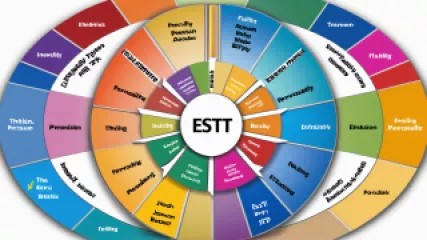The Ultimate Guide to Understanding Personality Types
The Ultimate Guide to Understanding Personality Types
Personality is a complex and fascinating topic that has captured the attention of psychologists, philosophers, and individuals alike for centuries. From the ancient Greek concept of the four temperaments to the modern Myers-Briggs Type Indicator, the study of personality has evolved, providing us with a deeper understanding of ourselves and those around us. In this ultimate guide, we will delve into the world of personality types, exploring the various theories, assessments, and practical applications that can help us unlock the secrets of our unique identities.
Defining Personality: The Building Blocks of Who We Are
At its core, personality refers to the unique set of traits, behaviors, and characteristics that define an individual. It is the combination of our thoughts, feelings, and actions that shapes our interactions with the world and the people in it. Personality is often described as the "psychological blueprint" that guides our decision-making, communication styles, and overall approach to life.
Researchers have long debated the origins of personality, with theories ranging from the innate and genetic to the environmental and experiential. Some believe that our personalities are largely predetermined, while others argue that they are shaped by the experiences and influences we encounter throughout our lives. Regardless of the source, one thing is certain: understanding our own personality and the personalities of those around us can be a powerful tool for personal growth, interpersonal relationships, and overall well-being.
The Importance of Personality Assessment
Personality assessment is the process of evaluating and measuring an individual's unique personality traits, preferences, and tendencies. These assessments can take many forms, from self-reported questionnaires to in-depth psychological evaluations. By understanding our personality profiles, we can gain valuable insights into our strengths, weaknesses, and the ways in which we interact with the world.
One of the most well-known and widely used personality assessments is the Myers-Briggs Type Indicator (MBTI). Developed in the 1940s by Katherine Briggs and Isabel Briggs Myers, the MBTI is based on the work of Swiss psychologist Carl Jung and his theory of psychological types. The MBTI categorizes individuals into one of 16 distinct personality types, each with its own unique blend of preferences and tendencies.
Other popular personality assessments include the Big Five personality traits, the Enneagram, and the DiSC assessment. Each of these tools provides a different lens through which we can explore our personalities, offering unique insights and practical applications.
The Myers-Briggs Type Indicator (MBTI): Uncovering Your Personality Type
The MBTI is perhaps the most well-known and widely used personality assessment tool, with millions of individuals around the world having completed the questionnaire. The MBTI is based on the premise that there are four key dichotomies that define our personalities:
- Extroversion (E) vs. Introversion (I): This dimension reflects our preference for engaging with the external world (extroversion) or the internal world of thoughts and feelings (introversion).
- Sensing (S) vs. Intuition (N): This dimension reflects our preference for processing information through our senses (sensing) or through intuition and abstract thinking (intuition).
- Thinking (T) vs. Feeling (F): This dimension reflects our preference for making decisions based on logic and analysis (thinking) or based on personal values and emotions (feeling).
- Judging (J) vs. Perceiving (P): This dimension reflects our preference for structure and order (judging) or for flexibility and spontaneity (perceiving).
By combining these four dichotomies, the MBTI identifies 16 distinct personality types, each with its own unique strengths, weaknesses, and preferred ways of interacting with the world. From the outgoing and analytical ENTJ (the "Commander") to the introspective and compassionate INFJ (the "Advocate"), the MBTI provides a comprehensive framework for understanding the rich diversity of human personality.
Exploring the 16 MBTI Personality Types
Let's take a closer look at the 16 MBTI personality types and the characteristics that define them:
Extraverted Thinking Types:
- ESTJ (The Executive): Practical, organized, and decisive, ESTJs are natural leaders who thrive in structured environments. They value efficiency, tradition, and a clear chain of command.
- ENTJ (The Commander): Confident, strategic, and goal-oriented, ENTJs are natural-born leaders who excel at problem-solving and decision-making. They are often described as assertive and ambitious.
Introverted Thinking Types:
- ISTP (The Virtuoso): Practical, analytical, and independent, ISTPs are adept at troubleshooting and working with their hands. They prefer a hands-on approach and thrive in fast-paced, action-oriented environments.
- INTP (The Logician): Curious, intellectual, and unconventional, INTPs are natural problem-solvers who excel at theoretical and abstract thinking. They are often described as independent, curious, and creative.
Extraverted Feeling Types:
- ESFJ (The Consul): Practical, social, and conscientious, ESFJs are often described as the "hosts" of the personality type spectrum. They value harmony, tradition, and a sense of belonging.
- ENFJ (The Protagonist): Charismatic, empathetic, and idealistic, ENFJs are natural leaders who excel at motivating and inspiring others. They are often described as passionate, caring, and purpose-driven.
Introverted Feeling Types:
- ISFJ (The Defender): Loyal, detail-oriented, and conscientious, ISFJs are often described as the "backbone" of organizations. They value tradition, security, and a sense of duty.
- INFJ (The Advocate): Insightful, compassionate, and idealistic, INFJs are often described as the "rarest" of the personality types. They are driven by a strong sense of purpose and a desire to make a positive impact on the world.
Extraverted Sensing Types:
- ESTP (The Entrepreneur): Adaptable, spontaneous, and action-oriented, ESTPs thrive in fast-paced, dynamic environments. They are often described as charismatic, risk-taking, and pragmatic.
- ESFP (The Entertainer): Outgoing, empathetic, and adaptable, ESFPs are often described as the "life of the party." They value experiences, sensory pleasures, and a good time.
Introverted Sensing Types:
- ISTJ (The Logistician): Responsible, detail-oriented, and practical, ISTJs are often described as the "backbone" of organizations. They value tradition, stability, and a strong work ethic.
- ISFJ (The Defender): Loyal, detail-oriented, and conscientious, ISFJs are often described as the "backbone" of organizations. They value tradition, security, and a sense of duty.
Extraverted Intuitive Types:
- ENTP (The Debater): Curious, unconventional, and adaptable, ENTPs are often described as the "idea generators" of the personality type spectrum. They excel at problem-solving and thrive in environments that encourage intellectual discourse.
- ENFP (The Campaigner): Passionate, imaginative, and adaptable, ENFPs are often described as the "free spirits" of the personality type spectrum. They value authenticity, personal growth, and a sense of purpose.
Introverted Intuitive Types:
- INTJ (The Architect): Analytical, strategic, and independent, INTJs are often described as the "masterminds" of the personality type spectrum. They excel at long-term planning, problem-solving, and innovative thinking.
- INFJ (The Advocate): Insightful, compassionate, and idealistic, INFJs are often described as the "rarest" of the personality types. They are driven by a strong sense of purpose and a desire to make a positive impact on the world.
Applying Personality Insights to Everyday Life
Understanding your own personality type, as well as the personality types of those around you, can have a profound impact on various aspects of your life. Here are some ways in which personality insights can be applied:
Relationships and Communication
Knowing your own personality type and the types of those close to you can greatly improve your ability to communicate effectively, resolve conflicts, and build stronger, more fulfilling relationships. For example, an extroverted, feeling-oriented person may have a different communication style than an introverted, thinking-oriented person, and being aware of these differences can help you bridge the gap and find common ground.
Career and Professional Development
Personality assessments can also be valuable tools in the professional realm. By understanding your strengths, weaknesses, and preferred work environments, you can make more informed decisions about your career path, identify potential areas of growth, and find roles that align with your natural tendencies and abilities.
Personal Growth and Self-Awareness
Exploring your personality type can also be a powerful tool for personal growth and self-discovery. By gaining a deeper understanding of your motivations, values, and natural inclinations, you can work on developing your weaker areas, capitalize on your strengths, and cultivate a greater sense of self-awareness.
The Nuances of Personality: Exploring Subtypes and Enneagram Types
While the MBTI provides a comprehensive framework for understanding personality types, it is important to recognize that there are often nuances and variations within each type. This is where other personality assessment tools, such as the Enneagram, can offer additional insights.
The Enneagram is a personality typing system that identifies nine distinct personality types, each with its own set of motivations, fears, and patterns of behavior. Unlike the MBTI, which focuses on preferences and cognitive functions, the Enneagram delves deeper into the emotional and psychological drivers that shape our personalities.
By understanding your Enneagram type, you can gain a more nuanced understanding of your personality, including your core motivations, your blindspots, and the ways in which you respond to stress and personal growth. This can be a valuable complement to the insights provided by the MBTI, offering a more holistic and multifaceted perspective on your unique personality.
The Evolution of Personality Assessment: Embracing New Perspectives
As our understanding of personality continues to evolve, new perspectives and assessment tools are emerging. From advancements in neuroscience and genetic research to the integration of mindfulness and emotional intelligence, the field of personality psychology is constantly expanding and adapting to the changing needs and complexities of modern life.
One such example is the growing emphasis on the role of personality in mental health and well-being. Personality traits have been linked to various psychological conditions, including anxiety, depression, and resilience. By understanding the interplay between personality and mental health, we can develop more targeted and effective approaches to therapy and self-care.
Additionally, the increasing focus on diversity, inclusion, and cultural competence has also influenced the way we approach personality assessment. As we recognize the importance of acknowledging and embracing individual differences, personality assessment tools must adapt to provide a more inclusive and nuanced understanding of human personality.
Unlocking Your Potential: Applying Personality Insights for Personal Growth
Ultimately, the study of personality is not just an academic pursuit – it is a powerful tool for personal growth, self-discovery, and meaningful connection with others. By understanding the complexities of our own personalities and the personalities of those around us, we can navigate the challenges of daily life with greater awareness, empathy, and resilience.
Whether you are exploring the MBTI, the Enneagram, or other personality assessment tools, the journey of self-discovery can be both enlightening and transformative. By embracing the richness and diversity of human personality, we can cultivate a deeper understanding of ourselves and our relationships, ultimately leading to a more fulfilling and purposeful life.
In conclusion, the ultimate guide to understanding personality types has provided a comprehensive overview of the fascinating world of personality assessment. From the foundational principles of the MBTI to the nuances of the Enneagram, we have delved into the complexities of human personality, exploring the ways in which these insights can be applied to various aspects of our lives.
As we continue to unravel the mysteries of personality, let us embrace the opportunity for personal growth, empathy, and connection. By cultivating a deeper understanding of ourselves and those around us, we can navigate the challenges of life with greater clarity, resilience, and purpose.
Remember, the journey of self-discovery is an ongoing process, and there is always more to learn. So, let us embark on this journey with curiosity, openness, and a willingness to embrace the richness and diversity of human personality.






